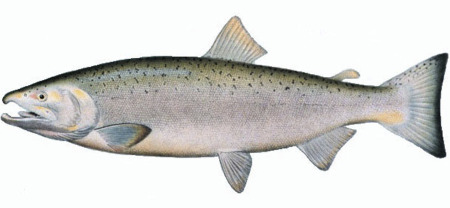
Oncorhynchus kisutch (Coho Salmon, Silver Salmon) is an anadromous fish, with a native spawning range in: 'Arctic and Pacific drainages; Cape Hope, Alaska to Monterey Bay, California. Also in northeast Asia, Page and Burr 1991' while the adults range widely in the cooler waters of the North Pacific. The Coho Salmon is a cold-water fish, not tolerating temperatures over 25“C. It has been widely introduced outside its range in North America by the US Fish Commission, and state agencies. After many unsuccessful introductions of the Chinook Salmon (O. tshawytscha) in the 1870s-1889s, the agencies turned their attention to the Coho Salmon in the early 1900s. Some successful spawning was seen in Maine estuaries, but populations did not persist. Their was a revival of interest and stocking in Massachusetts, New Hampshire, and Maine in the 19t0s-1980s, and adult salmon were found as far south as Virginia, but populations were not established. Early introductions in the Great Lakes, in the 1930s were unsuccessful, but stockings in the 1960s-1970s were more successful, with some natural reproduction, but with fisheries still dependent on stocking. Altogether, O. kisutch has been introduced to non-native drainages in at least 32 states, but aside from the Great Lakes populations, most of these efforts have been unsuccessful Coho Salmon appeared in France, in the 1980s, and became widespread for a few years, but did not become established. They escaped form aquaculture in Chile, and are established there, and also on the subantarctic island of Kerguelen.